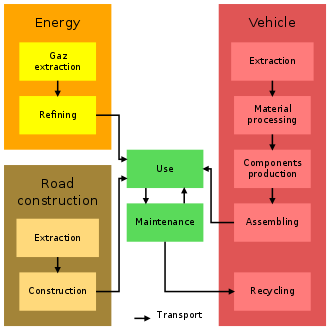Circular economy
(Redirected from Circular Economy)
File:Towards a Circular City.webm Circular economy is an economic system aimed at eliminating waste and the continual use of resources. Circular systems employ reuse, sharing, repair, refurbishment, remanufacturing and recycling to create a closed-loop system, minimizing the use of resource inputs and the creation of waste, pollution, and carbon emissions. The circular economy aims to keep products, equipment, and infrastructure in use for longer, thus improving the productivity of these resources. All 'waste' should be seen as a resource.
Principles
The principles of the circular economy can be summarized into three key points:
- Design out waste and pollution: By rethinking how resources are used, products and processes can be designed from the outset to minimize waste and pollution.
- Keep products and materials in use: This involves designing for durability, reuse, remanufacturability, and recyclability to keep materials circulating in the economy.
- Regenerate natural systems: The circular economy seeks not only to minimize negative impacts but to have a positive effect on the environment through practices that restore and regenerate natural systems.
Benefits
The circular economy offers several benefits, including reducing pressure on the environment, improving the security of the supply of raw materials, increasing competitiveness, stimulating innovation, boosting economic growth, and creating jobs. It also provides a way to tackle climate change by lowering carbon emissions and optimizing resource efficiency.
Implementation
Implementing the circular economy requires changes across the board: from product design and manufacturing processes to new business and market models, from new ways of delivering services to new consumer behaviors. It involves stakeholders across the value chain, including manufacturers, consumers, policymakers, and those involved in waste management and recycling.
Challenges
Transitioning to a circular economy also presents challenges, such as the need for large-scale redesign of processes and products, development of new materials, and changes in consumer behavior. There are also economic and regulatory hurdles, as well as the need for investment in new technologies and infrastructure.
Examples
Examples of circular economy practices include:
- Product as a Service (PaaS) models, where consumers lease or rent products instead of owning them outright, encouraging manufacturers to design for longevity and easy maintenance.
- Industrial symbiosis, where waste or by-products of one industry become the raw materials for another.
- Comprehensive recycling and upcycling programs that transform waste materials into new products.
See also
Transform your life with W8MD's budget GLP-1 injections from $125.
W8MD offers a medical weight loss program to lose weight in Philadelphia. Our physician-supervised medical weight loss provides:
- Most insurances accepted or discounted self-pay rates. We will obtain insurance prior authorizations if needed.
- Generic GLP1 weight loss injections from $125 for the starting dose.
- Also offer prescription weight loss medications including Phentermine, Qsymia, Diethylpropion, Contrave etc.
NYC weight loss doctor appointments
Start your NYC weight loss journey today at our NYC medical weight loss and Philadelphia medical weight loss clinics.
- Call 718-946-5500 to lose weight in NYC or for medical weight loss in Philadelphia 215-676-2334.
- Tags:NYC medical weight loss, Philadelphia lose weight Zepbound NYC, Budget GLP1 weight loss injections, Wegovy Philadelphia, Wegovy NYC, Philadelphia medical weight loss, Brookly weight loss and Wegovy NYC
|
WikiMD's Wellness Encyclopedia |
| Let Food Be Thy Medicine Medicine Thy Food - Hippocrates |
Medical Disclaimer: WikiMD is not a substitute for professional medical advice. The information on WikiMD is provided as an information resource only, may be incorrect, outdated or misleading, and is not to be used or relied on for any diagnostic or treatment purposes. Please consult your health care provider before making any healthcare decisions or for guidance about a specific medical condition. WikiMD expressly disclaims responsibility, and shall have no liability, for any damages, loss, injury, or liability whatsoever suffered as a result of your reliance on the information contained in this site. By visiting this site you agree to the foregoing terms and conditions, which may from time to time be changed or supplemented by WikiMD. If you do not agree to the foregoing terms and conditions, you should not enter or use this site. See full disclaimer.
Credits:Most images are courtesy of Wikimedia commons, and templates, categories Wikipedia, licensed under CC BY SA or similar.
Translate this page: - East Asian
中文,
日本,
한국어,
South Asian
हिन्दी,
தமிழ்,
తెలుగు,
Urdu,
ಕನ್ನಡ,
Southeast Asian
Indonesian,
Vietnamese,
Thai,
မြန်မာဘာသာ,
বাংলা
European
español,
Deutsch,
français,
Greek,
português do Brasil,
polski,
română,
русский,
Nederlands,
norsk,
svenska,
suomi,
Italian
Middle Eastern & African
عربى,
Turkish,
Persian,
Hebrew,
Afrikaans,
isiZulu,
Kiswahili,
Other
Bulgarian,
Hungarian,
Czech,
Swedish,
മലയാളം,
मराठी,
ਪੰਜਾਬੀ,
ગુજરાતી,
Portuguese,
Ukrainian
Contributors: Prab R. Tumpati, MD



